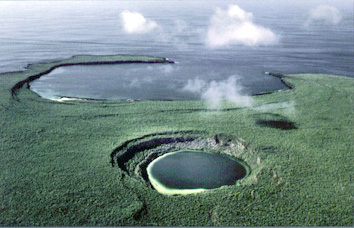|
Description of the Galapagos Islands Isla Genovesa  | | The floor of Genovesa's caldera is below sea level and breaked on the south side, forming Darwin Bay. Picture source: http://www.geo.cornell.edu/geology/GalapagosWWW/Genovesa.html |
Genovesa, also known as Tower Island, though small, is one of the most interesting both geologically and biologically. It is unusual geologically because the chemistry of its lavas is virtually identical to lavas that erupt at mid-ocean ridges (a magma type called MORB, or mid-ocean-ridge-basalt) and quite different from most oceanic island lavas. A great variety of nesting birds may be seen there, including masked boobies, red-footed boobies, Galapagos owls, frigates, swallow-tail gulls, lava herons, and the rare lava gulls. Also to be seen there are sea lions and fur seals. The fur seal, actually a species of sea lion rather than a true seal, was nearly hunted to extinction by the early part of the twentieth century, but has recovered.
The island consists of a single volcano, which emerges only 200 feet above sea level. A breached caldera on the south side of the island forms Darwin Bay. A small lake-filled crater is located in the center of the island. Because of the low potassium concentrations in the lavas, it has not been possible to determine the age of the island, but many of the lavas on Genovesa appear quite young, and are probably less than a few thousand years old. Thus although there have been no historic eruptions on the island, the volcano should be considered active, though dormant.
|







